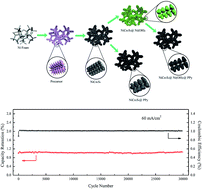Enhanced cycling stability of hierarchical NiCo2S4@Ni(OH)2@PPy core–shell nanotube arrays for aqueous asymmetric supercapacitors†
Abstract
In this article, a novel electrode of NiCo2S4@Ni(OH)2@polypyrrole nanotube arrays supported on nickel foam is fabricated through a facile method. Due to the superior electronic conductivity of the shell material polypyrrole (PPy) and the high pseudocapacitance of Ni(OH)2 together with the short ion transport pathway of NiCo2S4 nanotube arrays, the obtained core–shell NiCo2S4@Ni(OH)2@PPy shows an enhanced pseudocapacitive performance of about 9.1125 F cm−2 at a current density of 5 mA cm−2, which is nearly three times higher than that of the pristine NiCo2S4 sample (3.1875 F cm−2). The kinetic analysis reveals the diffusion controlled faradaic characteristic of NiCo2S4@Ni(OH)2@PPy (43.57% capacitive contribution). Moreover, an asymmetric supercapacitor is successfully assembled with NiCo2S4@Ni(OH)2@PPy as the positive electrode and active carbon (AC) as the negative electrode. The NiCo2S4@Ni(OH)2@PPy//AC device exhibits a relatively high energy density of 34.67 W h kg−1 at a power density of 120.127 W kg−1 and excellent cycling performance (about 98.87% capacitance retention over 30 000 cycles). The results show that the NiCo2S4@Ni(OH)2@PPy core–shell nanotube array is a promising electrode material for high performance supercapacitor applications.



 Please wait while we load your content...
Please wait while we load your content...